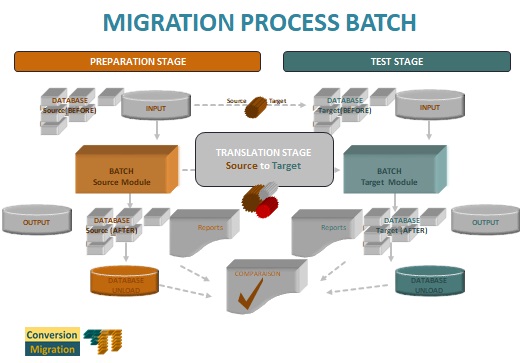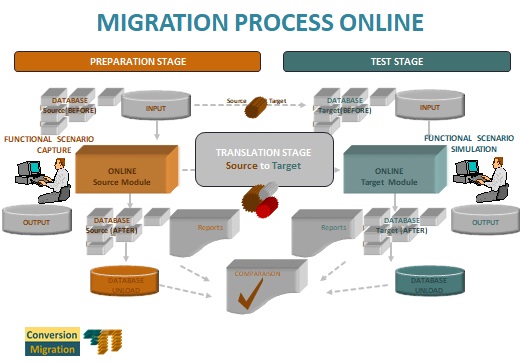|
|
|
The emphasis on thorough unit testing often reduces costly system and parallel testing time. Carefully selected and prepared test data can save thousands of dollars and hundreds of hours during the testing phase of the transformation process. Such data can also help to minimize the subtle processing problems that a migration can generate. Conversion Migration not only helps to produce comprehensive test data, but also helps to reduce data preparation time. Though most production databases and files are large, they seldom contain data that test all the conditions of a program or system. Using production files for initial testing can, therefore, result in long costly runs that do not adequately test the program code. It can also prolong debugging time as the programmer analyzes voluminous output. Conversion Migration offers effective techniques and software for extracting or generating small, manageable test files. These files ensure efficient, comprehensive testing and avoid costly reruns during implementation. Because they shorten test runs, they save machine time and increase turnaround for the migration team. Percentage of execution is measured during preparation or, as required, after translation. Even if the output files & databases match, the program may still be inadequately tested if the test data exercise only a fraction of the program code. Conversion Migration therefore identifies any unexecuted code, making it possible to prepare additional data.
TRANSLATION PHASE |
STAGES | TASKS | DELIVERY | TOOLS | ACTORS |
|
Component Extraction | Conversion Migration |
Production
Manager CLIENT |
||
Program |
Language
Translation |
|
|
Project
leader |
|
Test |
Unit
tests, |
|
Conversion Migration |
Project leader Analyst Developers Project Leader CLIENT Application Manager CLIENT |
|
Delivery |
Test
Results |
Project leader Project Leader CLIENT |
BATCH AND TRANSACTIONAL TEST Conversion Migration automates many of the repetitive task associated with generating job control language, generating database unload, format and load programs, translating programs, translating screens, translating reports and converting databases and files. Conversion Migration produces new programs functionally equivalent to the old programs, but stripped of dependency on the old language, database or computer. It can even restructure programs and database access with uniform standards. The transformation process also limits the redundancy and expansion of code. For each combination of source and target programs, a certain number of tests are necessary to check all program conditions. An insufficient number of tests during unit migration only postpones this requirement until the implementation phase, where runs are longer and more costly. Conversion Migration stresses the discovery and correction of errors during unit testing and not during production runs. For every test, Conversion Migration compares the output of the transformed program with the converted output of the original program and flags any mismatches for the correction. Every function represented by the test data is therefore present and working in the converted program. We make sure that the migrated programs will produce output functionally equivalent to that produced by the original programs.
|
|
|
|
 |
MIGRATION PROCESS FOR BATCH TEST 3 types of test units are envisaged: the program (single test), the job (job test), a group of jobs (chain test). The type of test unit is determined according to criteria like: the number of files updated by the programs of the test. The problem is how to identify the location of update errors (which program), the environment constraints like disk spaces or number of databases, ... The preparation stage consists of including in the preparation environment the capture of input and updated files before the unit to be tested (before images) and the capture of updated and output files after this unit (after images). The capture will be done by standard utilities. Usually the captured files, called reference files, are gathered on one or more "dumped" files (tapes) for a batch of programs. After defining the constraints in production environment, the necessary JCL will be generated by Conversion Migration preparation tools. The tests stage consists in restoring the reference files in the test environment, executing the translated program of the test unit and comparing the resultant files with the after image reference files. This is done by a job related to the unit to be tested generated by Conversion Migration translation tools. |
 |
MIGRATION PROCESS FOR TRANSACTIONAL TEST The preparation stage consists in:
The tests stage consists in:
|
Conversion migration project phases.
 |
 |
 |
 |
 |
 |